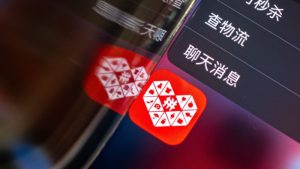Want to shop smarter? There’s an app for that
Everyone I know takes a different approach to shopping. Some scroll through their preferred etailer’s new-in sections at least once a week. Others specialise in highly specific saved eBay searches. A few are planners who buy two or three items per season, while most admit that they’re more emotional and impulsive with their purchases. One woman told me she loathes fitting rooms and never tries clothes on before buying; she returns or resells anything that doesn’t work out. “Excuse me,” someone else replied when I asked friends and contacts to describe how they shop. “Do you have 10 hours?”
Strategies abound, and with good reason: while luxury prices have spiralled upwards, inconsistencies across the ecommerce landscape means that pricing can seem both extortionate and arbitrary — the same item may cost more or less, depending on where you buy it. But today’s fashion clients are savvy about finding the best deal, and a growing segment is using price-tracking apps and other tools to make sure that they do. “We’re all so time-poor, but spend our time online clicking and scrolling through product pages,” says Emily Gaunt.
Gaunt is the founder of Radar, a new UK-based app that offers price comparison and tracking across retailers, resale and rental platforms. See something online and tap ‘Put item on my Radar’; the app then scours shopping platforms to find prices for the product wherever it’s listed, and sends push notifications to alert users to price drops and sales.
It’s intuitive and fun — within seconds of tapping to add Bally’s Pathy leather loafers from Farfetch, where they cost £760, the app found them for £720 on Net-a-porter.com, and £697 from a Como-based boutique. (It also informed me that an Ulla Johnson dress I bought recently could have been mine for 10 per cent less, had I checked that one platform I always forget about before buying it elsewhere. Dang.)
“What we want is for people to use it and say, ‘How did we ever shop without this?’” Gaunt says. “We’re reducing the need to scroll and click in a traditional way. It comes down to giving shoppers the ability to make considered, smart shopping decisions, and really take control.”

The idea for Radar grew out of what Gaunt, a former people and strategy consultant in financial services with no previous fashion or tech experience, describes as frustration with her scattershot approach to wishlisting and screenshotting products. “I wanted to find a solution where I could save all those items in one place, track those prices constantly and then compare across the market to find the best places to buy.” She began developing the concept in January 2023, launching the open beta app in March 2024. Six months in, the app has some 2,000 users with repeat users averaging four sessions per week. The core user base is women aged 30 to 35: “tech-literate, time-poor shoppers who are willing to spend but want to make sure they’re not wasting money,” Gaunt says.
Incorporating resale and rental platforms is an achievement for Radar as few other sites offer this capability. For Gaunt, it was a priority “because they’re part of the decision-making process. If you’re shopping for a wedding and find a Self-Portrait dress you like for £360, then see that Hurr have it for rent for £65, and it’s on Vestiaire Collective for £220, that gives you the opportunity to consider the impact of your choices and take more control of your buying decisions.”
The main challenge is getting people to download yet another app. Most users discover Radar through word of mouth or influencer activity, and the team has marketed the app in-person at university freshers’ weeks. And while you might expect retailers to disdain a platform-agnostic app that reduces purchasing decisions to pure numbers, “they see the benefit of it”, Gaunt adds, noting that Radar pushes users back to the retailers to complete transactions.
Radar isn’t the only app to offer price-tracking. At Lyst, users can compile a universal wishlist of pieces from their favourite stores and register for back-in-stock alerts. Analysts at the data-driven shopping app have registered a growing sophistication in searches. Ninety per cent of searches now include a brand name, with many savvier customers (including those who don’t work in fashion) searching for specific products, SKU numbers and seasons. Instead of searching for black flats, they’re seeking Alaïa Strass ballet flats. “People have a heightened brand-name awareness . . . [and] understanding of what brands are known for,” says Miyon Im, Lyst VP of product design.


The most frustrating hurdle on a shopping journey can be the dreaded “sold out” tag. When back-in-stock alerts and internet-wide searches aren’t enough, the most motivated shoppers are turning to sourcing experts — fashion professionals who specialise in tracking down hard-to-find pieces for private clients. Until recently, sourcing was a niche activity centred on WhatsApps with personal shoppers (Threads Styling offers this service) or DMs with individual sourcers. Now it’s becoming (relatively) more accessible thanks to Sourcewhere, a fashion sourcing app, which promises to locate fashion items from past and current seasons.
“Our users are incredibly savvy,” says founder and CEO Erica Wright, previously of MyTheresa and Net-a-Porter. “They’ve already done the work and researched specific pieces. What we’re doing is catering to this ever-evolving preference of smart luxury consumers who really value efficiency and want a personal experience.”
Users place requests in the app and are matched with a sourcing expert. Once the expert locates the desired item, the user pays an agreed price plus a sourcing fee (typically 10 per cent of the order value) in a secure chat. There are 50 sourcing experts on the network, ranging from personal shoppers to archive collectors (one exclusively sources pieces from the Margiela era at Hermès; two specialise in Phoebe Philo-era Céline). Match-to-order time can take 15 minutes (for a pair of The Row Mara flats) or 18 months (a Margiela-for-Hermès runway suit jacket from SS1999). The average order value is £1,100.
The main reasons shoppers turn to sourcing are access and convenience, says Gab Waller, who sources designer goods for Rosie Huntington-Whiteley and Hailey Bieber (Waller is also on Sourcewhere). Especially with in-demand items, there can be high barriers to entry — either hours of queueing to get into a boutique, or an expectation of an existing client relationship (the dreaded “pre-spend”). “Sourcing solves that. And now that the consumer is more knowledgeable about trends and what’s happening, they know they can tap into it to find what they’re looking for.”
The apps may do the heavy lifting, but the bragging rights when it comes to actually wearing that sold-out leopard-print Alaïa miniskirt? Shopper’s own.
Sign up for Fashion Matters, your weekly newsletter with the latest stories in style. Follow @financialtimesfashion on Instagram and subscribe to our podcast Life and Art wherever you listen
#shop #smarter #app







